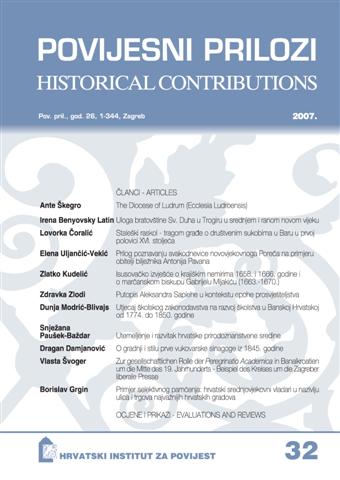O gradnji i stilu prve vukovarske sinagoge iz 1845. godine
About the building and style of the first synagogue in vukovar (1845)
Author(s): Dragan DamjanovićSubject(s): History
Published by: Hrvatski institut za povijest
Keywords: Vukovar; Jews; synagogue; classicism; Egyptian style (Egyptian Revival)
Summary/Abstract: The first synagogue in Vukovar, founded in 1845, was also the first dedicated building of synagogue in the Threefold Kingdom of Croatia, Slavonia and Dalmatia. The edifice of this synagogue provoked many protest of the majority of Catholic and Orthodox population. They tried to stop erection of synagogue by stressing that this construction was designed against communal plan, namely that it would narrow Gaj Street and thus complicate traffic in this street. In fact they were mostly afraid that this synagogue would encourage further immigration of Jews, who were considered as great competitors to the local tradesmen and craftsmen. Citizens of Vukovar protested before the government of County of Srijem, as well as before Josip Kuković the bishop of Đakovo. Regardless their efforts, they did not manage to stop the edification, since the Jewish Community acquired all the necessary legal grounds for their enterprise. Namely, Jews claimed that this was not to be a temple (synagogue), since such buildings were prohibited to build at that time, but only a praying house (Domus oratorium, Betthaus). Moreover, the president of Jewish Community at that time, Friedrich Singer, stated that this building had to have an auxiliary edifice with a kitchen. Finally, all this arguments were enough satisfactory to the city authorities and the synagogue was completed. This first synagogue in Vukovar was a rather small edifice but very interesting regarding its style, since embraced elements of classicism that dominate on the front facade (typical for the architecture of the first half of the nineteenth century) together with elements of Egyptian style (Egyptian revival) on the side facade. These Egyptian elements are rather common in the synagogue architecture at that time but in contemporary Croatia this was the only example. This edifice was used as synagogue till 1889, when it was replaced by a monumental temple in neo-Romanesque – neo-Mauro style. The old edifice was sold to the Calvin community in 1894/1895. Henceforth it was used as a Christian temple until it was demolished during the 60s of the twentieth century.
Journal: Povijesni prilozi
- Issue Year: 2007
- Issue No: 32
- Page Range: 241-257
- Page Count: 16
- Language: Croatian

